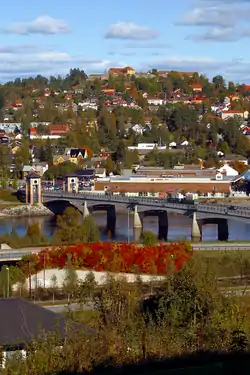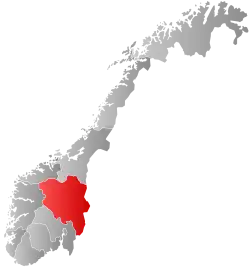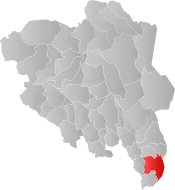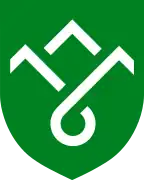Kongsvinger
Kongsvinger (ⓘ) is a municipality in Innlandet county, Norway. It is located in the traditional district of Glåmdal. The administrative centre of the municipality is the town of Kongsvinger. Other settlements in the municipality include Austmarka, Brandval, Lundersæter, and Roverud.[2]
Kongsvinger kommune | |
|---|---|
 View of the town (September 2009) | |
 Innlandet within Norway | |
 Kongsvinger within Innlandet | |
| Coordinates: 60°14′35″N 12°13′32″E | |
| Country | Norway |
| County | Innlandet |
| District | Glåmdal |
| Established | 7 February 1855 |
| • Preceded by | Vinger Municipality |
| Administrative centre | Kongsvinger |
| Government | |
| • Mayor (2019) | Margrethe Haarr (Sp) |
| Area | |
| • Total | 1,036.44 km2 (400.17 sq mi) |
| • Land | 952.82 km2 (367.89 sq mi) |
| • Water | 83.62 km2 (32.29 sq mi) 8.1% |
| • Rank | #111 in Norway |
| Population (2022) | |
| • Total | 17,949 |
| • Rank | #72 in Norway |
| • Density | 18.8/km2 (49/sq mi) |
| • Change (10 years) | |
| Official language | |
| • Norwegian form | Bokmål |
| Time zone | UTC+01:00 (CET) |
| • Summer (DST) | UTC+02:00 (CEST) |
| ISO 3166 code | NO-3401 |
| Website | Official website |
The 1,036-square-kilometre (400 sq mi) municipality is the 111th largest by area out of the 356 municipalities in Norway. Kongsvinger is the 72nd most populous municipality in Norway with a population of 17,949. The municipality's population density is 18.8 inhabitants per square kilometre (49/sq mi) and its population has increased by 2.4% over the previous 10-year period.[3][4] Kongsvinger's eastern municipal boundary is the Norway–Sweden border.
General information
In 1854, the King designated the market town of Kongsvinger as a kjøpstad, which gave it special rights. The designation included a small patch of land on both sides of the river Glomma with an area of approximately 5.2 square kilometres (2 sq mi). Because of this designation, on 7 February 1855, the town was separated from the municipality of Vinger to form a separate municipality. Initially, the town had 472 residents and this left Vinger municipality with 10,947 residents. On 1 January 1876, the town was enlarged when an area of Vinger (population: 209) was transferred into Kongsvinger. During the 1960s, there were many municipal mergers across Norway due to the work of the Schei Committee. On 1 January 1964, the town of Kongsvinger (population: 2,345) and the surrounding municipalities of Vinger (population: 6,257) and Brandval (population: 4,384) were merged to form the new Kongsvinger Municipality. The new municipality of Kongsvinger (briefly) lost its status as an urban municipality (Norwegian: bykommune) after this amalgamation due to merging with rural municipalities. One year later, on 1 January 1965, the government redesignated Kongsvinger as an urban municipality. On 1 January 1974, the unpopulated Lystad area was transferred from Grue Municipality to Kongsvinger Municipality. On 1 January 1986, the northern part of the Åbogen area (population: 14) was transferred from Kongsvinger to the neighboring municipality of Eidskog.[5]
Name
The whole region where Kongsvinger is located was historically called Vinger (Old Norse: Vingr). This name could be related to the river Glomma which flows through the region. One could compare this to the English word swing (for the missing s see Indo-European s-mobile). The river Glomma passes through the center of the district where the south-flowing river takes a sharp northwestward turn. This can be compared to the similar Lithuanian word vìngis which means "bend", "bow", or "turn". This old name used to represent this whole area. The first element of the name Kongs- (meaning "the King's") was added after the Kongsvinger Fortress was built in 1690. It was first applied only to the fortress (written as Königs Winger in old documents). Then, it was later given to the town that grew up around it.[6][2]
Coat of arms
The coat of arms was granted on 25 June 1926. The design is a stylized representation of Kongsvinger Fortress towering high above the river Glomma. The river is rendered as a wavy bar in the bottom half of the design. The river and fortress have a tincture of argent which means they are commonly colored white, but if the arms are made out of metal, then silver is used. The lower part of the arms represent the land and the mountain on which the fortress sits. This area has a background in black to represent the local conifer forest. The curved upper part of the background is colored red to symbolize the sky. The color is taken from the Norwegian flag to mark the national historical importance of the fortress. A mural crown is often shown above the escutcheon to indicate that the town of Kongsvinger is located in the municipality. The arms were designed by J. W. Oftedal.[7][8]
Churches
The Church of Norway has three parishes (sokn) within the municipality of Kongsvinger. It is part of the Solør, Vinger og Odal prosti (deanery) in the Diocese of Hamar.
| Parish (sokn) | Church name | Location of the church | Year built |
|---|---|---|---|
| Austmarka | Austmarka Church | Austmarka | 1858 |
| Brandval | Brandval Church | Brandval | 1651 |
| Lundersæter Church | Lundersæter | 1868 | |
| Roverud Church | Roverud | 1969 | |
| Vinger | Vinger Church | Kongsvinger | 1699 |
History
The area was historically a part of the prestegjeld of Vinger. The village that later became Kongsvinger already existed as a trading center by the Middle Ages, due to the accessibility by natural waterways. Viking chieftains reached Sweden by boat from Kongsvinger. Kongsvinger Fortress was founded in 1669, and a star-shaped plan was laid out for the fortress. Work began in 1682 and it was finished in 1690 as part of a general upgrade to Norwegian fortresses.[9] The building of the fortress formed the foundations for what was to become the town of Kongsvinger. The fortress was built as a defensive structure against the Swedes, and on numerous occasions there have been military engagements in the area around the fortress, but Kongsvinger fortress has never been taken in military combat. Below Kongsvinger fortress lies Øvrebyen, which literally translated means "upper town". This is the oldest part of the town of Kongsvinger, and one can still find a number of the original houses built after the establishment of the fortress. Kongsvinger Museum is located here, together with a museum of female emancipation in a building called "Rolighed", the home of Dagny Juel, the famous author once portrayed by Edvard Munch.
The rural, eastern parts of Kongsvinger and its neighboring municipalities to the north and south were populated at the end of the 17th century by Finnish emigrants who came across the Swedish border. The area is called Finnskogen which means "The Finnish forest".
Kongsvinger played an important part in the Norwegian resistance force against the Nazis being a gateway to Sweden. Norway's highest decorated citizen, Gunnar Sønsteby frequently passed through Kongsvinger in his work to sabotage the Nazis' installations in Norway. Some of the busiest escape routes for refugees also went through Kongsvinger to Sweden.
From 1983 to 1999, and again in 2010, Kongsvinger's association football team KIL Toppfotball held a position in the Norwegian Premier League. It made some notable merits participating in the UEFA Cup and winning a silver medal during the 1992 season.
Government
All municipalities in Norway are responsible for primary education (through 10th grade), outpatient health services, senior citizen services, welfare and other social services, zoning, economic development, and municipal roads and utilities. The municipality is governed by a municipal council of directly elected representatives. The mayor is indirectly elected by a vote of the municipal council.[10] The municipality falls under the Romerike og Glåmdal District Court and the Eidsivating Court of Appeal.
Municipal council
The municipal council (Kommunestyre) of Kongsvinger is made up of 33 representatives that are elected to four year terms. The party breakdown of the council is as follows:
| Party Name (in Norwegian) | Number of representatives | |
|---|---|---|
| Labour Party (Arbeiderpartiet) | 10 | |
| Progress Party (Fremskrittspartiet) | 2 | |
| Green Party (Miljøpartiet De Grønne) | 1 | |
| Conservative Party (Høyre) | 4 | |
| Christian Democratic Party (Kristelig Folkeparti) | 1 | |
| Pensioners' Party (Pensjonistpartiet) | 3 | |
| Red Party (Rødt) | 1 | |
| Centre Party (Senterpartiet) | 8 | |
| Socialist Left Party (Sosialistisk Venstreparti) | 2 | |
| Liberal Party (Venstre) | 1 | |
| Total number of members: | 33 | |
| Party Name (in Norwegian) | Number of representatives | |
|---|---|---|
| Labour Party (Arbeiderpartiet) | 16 | |
| Progress Party (Fremskrittspartiet) | 3 | |
| Green Party (Miljøpartiet De Grønne) | 1 | |
| Conservative Party (Høyre) | 6 | |
| Christian Democratic Party (Kristelig Folkeparti) | 1 | |
| Pensioners' Party (Pensjonistpartiet) | 2 | |
| Centre Party (Senterpartiet) | 2 | |
| Socialist Left Party (Sosialistisk Venstreparti) | 1 | |
| Liberal Party (Venstre) | 1 | |
| Total number of members: | 33 | |
| Party Name (in Norwegian) | Number of representatives | |
|---|---|---|
| Labour Party (Arbeiderpartiet) | 11 | |
| Progress Party (Fremskrittspartiet) | 5 | |
| Conservative Party (Høyre) | 6 | |
| Christian Democratic Party (Kristelig Folkeparti) | 1 | |
| Pensioners' Party (Pensjonistpartiet) | 5 | |
| Centre Party (Senterpartiet) | 2 | |
| Socialist Left Party (Sosialistisk Venstreparti) | 1 | |
| Liberal Party (Venstre) | 2 | |
| Total number of members: | 33 | |
| Party Name (in Norwegian) | Number of representatives | |
|---|---|---|
| Labour Party (Arbeiderpartiet) | 10 | |
| Progress Party (Fremskrittspartiet) | 6 | |
| Conservative Party (Høyre) | 5 | |
| Christian Democratic Party (Kristelig Folkeparti) | 1 | |
| Pensioners' Party (Pensjonistpartiet) | 5 | |
| Centre Party (Senterpartiet) | 2 | |
| Socialist Left Party (Sosialistisk Venstreparti) | 3 | |
| Liberal Party (Venstre) | 1 | |
| Total number of members: | 33 | |
| Party Name (in Norwegian) | Number of representatives | |
|---|---|---|
| Labour Party (Arbeiderpartiet) | 12 | |
| Progress Party (Fremskrittspartiet) | 5 | |
| Conservative Party (Høyre) | 6 | |
| Christian Democratic Party (Kristelig Folkeparti) | 1 | |
| Centre Party (Senterpartiet) | 2 | |
| Socialist Left Party (Sosialistisk Venstreparti) | 6 | |
| Liberal Party (Venstre) | 1 | |
| Total number of members: | 33 | |
| Party Name (in Norwegian) | Number of representatives | |
|---|---|---|
| Labour Party (Arbeiderpartiet) | 12 | |
| Progress Party (Fremskrittspartiet) | 4 | |
| Conservative Party (Høyre) | 11 | |
| Christian Democratic Party (Kristelig Folkeparti) | 2 | |
| Centre Party (Senterpartiet) | 2 | |
| Socialist Left Party (Sosialistisk Venstreparti) | 5 | |
| Town and local list (By- og bygdelista) | 1 | |
| Total number of members: | 37 | |
| Party Name (in Norwegian) | Number of representatives | |
|---|---|---|
| Labour Party (Arbeiderpartiet) | 19 | |
| Progress Party (Fremskrittspartiet) | 4 | |
| Conservative Party (Høyre) | 9 | |
| Christian Democratic Party (Kristelig Folkeparti) | 1 | |
| Centre Party (Senterpartiet) | 4 | |
| Socialist Left Party (Sosialistisk Venstreparti) | 5 | |
| Liberal Party (Venstre) | 1 | |
| Free Democrats (Fridemokratene) | 1 | |
| Kongsvinger town and local list (Kongsvinger by og bygdeliste) | 1 | |
| Total number of members: | 45 | |
| Party Name (in Norwegian) | Number of representatives | |
|---|---|---|
| Labour Party (Arbeiderpartiet) | 20 | |
| Progress Party (Fremskrittspartiet) | 4 | |
| Conservative Party (Høyre) | 5 | |
| Christian Democratic Party (Kristelig Folkeparti) | 1 | |
| Centre Party (Senterpartiet) | 4 | |
| Socialist Left Party (Sosialistisk Venstreparti) | 9 | |
| Liberal Party (Venstre) | 1 | |
| Kongsvinger town and local list (Kongsvinger by og bygdeliste) | 1 | |
| Total number of members: | 45 | |
| Party Name (in Norwegian) | Number of representatives | |
|---|---|---|
| Labour Party (Arbeiderpartiet) | 27 | |
| Progress Party (Fremskrittspartiet) | 4 | |
| Conservative Party (Høyre) | 6 | |
| Christian Democratic Party (Kristelig Folkeparti) | 1 | |
| Centre Party (Senterpartiet) | 2 | |
| Socialist Left Party (Sosialistisk Venstreparti) | 4 | |
| Liberal Party (Venstre) | 1 | |
| Total number of members: | 45 | |
| Party Name (in Norwegian) | Number of representatives | |
|---|---|---|
| Labour Party (Arbeiderpartiet) | 28 | |
| Progress Party (Fremskrittspartiet) | 3 | |
| Conservative Party (Høyre) | 6 | |
| Christian Democratic Party (Kristelig Folkeparti) | 1 | |
| Centre Party (Senterpartiet) | 3 | |
| Socialist Left Party (Sosialistisk Venstreparti) | 3 | |
| Liberal Party (Venstre) | 1 | |
| Total number of members: | 45 | |
| Party Name (in Norwegian) | Number of representatives | |
|---|---|---|
| Labour Party (Arbeiderpartiet) | 27 | |
| Conservative Party (Høyre) | 8 | |
| Christian Democratic Party (Kristelig Folkeparti) | 2 | |
| Centre Party (Senterpartiet) | 4 | |
| Socialist Left Party (Sosialistisk Venstreparti) | 3 | |
| Liberal Party (Venstre) | 1 | |
| Total number of members: | 45 | |
| Party Name (in Norwegian) | Number of representatives | |
|---|---|---|
| Labour Party (Arbeiderpartiet) | 28 | |
| Conservative Party (Høyre) | 5 | |
| Christian Democratic Party (Kristelig Folkeparti) | 2 | |
| New People's Party (Nye Folkepartiet) | 1 | |
| Centre Party (Senterpartiet) | 5 | |
| Socialist Left Party (Sosialistisk Venstreparti) | 4 | |
| Total number of members: | 45 | |
| Party Name (in Norwegian) | Number of representatives | |
|---|---|---|
| Labour Party (Arbeiderpartiet) | 31 | |
| Conservative Party (Høyre) | 4 | |
| Communist Party (Kommunistiske Parti) | 1 | |
| Christian Democratic Party (Kristelig Folkeparti) | 1 | |
| Centre Party (Senterpartiet) | 4 | |
| Socialist People's Party (Sosialistisk Folkeparti) | 3 | |
| Liberal Party (Venstre) | 1 | |
| Total number of members: | 45 | |
| Party Name (in Norwegian) | Number of representatives | |
|---|---|---|
| Labour Party (Arbeiderpartiet) | 30 | |
| Conservative Party (Høyre) | 4 | |
| Communist Party (Kommunistiske Parti) | 1 | |
| Christian Democratic Party (Kristelig Folkeparti) | 1 | |
| Centre Party (Senterpartiet) | 4 | |
| Socialist People's Party (Sosialistisk Folkeparti) | 3 | |
| Liberal Party (Venstre) | 2 | |
| Total number of members: | 45 | |
| Party Name (in Norwegian) | Number of representatives | |
|---|---|---|
| Labour Party (Arbeiderpartiet) | 32 | |
| Conservative Party (Høyre) | 4 | |
| Communist Party (Kommunistiske Parti) | 2 | |
| Christian Democratic Party (Kristelig Folkeparti) | 1 | |
| Centre Party (Senterpartiet) | 4 | |
| Liberal Party (Venstre) | 2 | |
| Total number of members: | 45 | |
| Note: On 1 January 1964, the town of Kongsvinger was merged with Brandval and Vinger to make a much larger municipality. | ||
| Party Name (in Norwegian) | Number of representatives | |
|---|---|---|
| Labour Party (Arbeiderpartiet) | 12 | |
| Conservative Party (Høyre) | 6 | |
| Liberal Party (Venstre) | 3 | |
| Total number of members: | 21 | |
| Party Name (in Norwegian) | Number of representatives | |
|---|---|---|
| Labour Party (Arbeiderpartiet) | 11 | |
| Conservative Party (Høyre) | 6 | |
| Liberal Party (Venstre) | 4 | |
| Total number of members: | 21 | |
| Party Name (in Norwegian) | Number of representatives | |
|---|---|---|
| Labour Party (Arbeiderpartiet) | 10 | |
| Conservative Party (Høyre) | 5 | |
| Communist Party (Kommunistiske Parti) | 1 | |
| Liberal Party (Venstre) | 4 | |
| Total number of members: | 20 | |
| Party Name (in Norwegian) | Number of representatives | |
|---|---|---|
| Labour Party (Arbeiderpartiet) | 9 | |
| Conservative Party (Høyre) | 5 | |
| Communist Party (Kommunistiske Parti) | 2 | |
| Joint list of the Liberal Party (Venstre) and the Radical People's Party (Radikale Folkepartiet) | 4 | |
| Total number of members: | 20 | |
| Party Name (in Norwegian) | Number of representatives | |
|---|---|---|
| Labour Party (Arbeiderpartiet) | 11 | |
| Communist Party (Kommunistiske Parti) | 1 | |
| Joint list of the Liberal Party (Venstre) and the Radical People's Party (Radikale Folkepartiet) | 2 | |
| Local List(s) (Lokale lister) | 6 | |
| Total number of members: | 20 | |
| Party Name (in Norwegian) | Number of representatives | |
|---|---|---|
| Labour Party (Arbeiderpartiet) | 7 | |
| Liberal Party (Venstre) | 5 | |
| Local List(s) (Lokale lister) | 8 | |
| Total number of members: | 20 | |
| Note: Due to the German occupation of Norway during World War II, no elections were held for new municipal councils until after the war ended in 1945. | ||
| Party Name (in Norwegian) | Number of representatives | |
|---|---|---|
| Labour Party (Arbeiderpartiet) | 7 | |
| Liberal Party (Venstre) | 5 | |
| Local List(s) (Lokale lister) | 8 | |
| Total number of members: | 20 | |
Mayors
The mayors of Kongsvinger:[31][32]
- 1855-1856: Jacob N. Hygen
- 1857-1859: S. Christian Strøm
- 1859-1859: Sigvald Rynning
- 1860-1860: Christian Kruse
- 1861-1877: Hans Hansen
- 1877-1880: C.F. Heidenreich
- 1881-1884: A. Knagenhjelm Blix
- 1885-1888: Lorentzo Rynning
- 1889-1898: Carl Henriksen
- 1899-1907: O.A. Herud
- 1908-1910: Otto Aamodt
- 1911-1913: O.A. Herud
- 1914-1914: Kristian Walby
- 1915-1919: Axel Engebretsen
- 1920-1920: Sigvald Olsen
- 1921-1922: Eiler Baanerud
- 1923-1925: Jacob Forseth
- 1926-1928: Thomas Johnsen
- 1929-1931: Eiler Baanerud
- 1932-1932: Christian Voss
- 1933-1933: H. Wallerud
- 1934-1934: Christian Voss
- 1935-1940: Eiler Baanerud
- 1940-1941: R. Talhaug (NS)
- 1942-1943: Erling Huseby (NS)
- 1944-1945: Johan Nitteberg (NS)
- 1945-1945: Eiler Baanerud
- 1946-1964: Aasmund Grimstad
- 1964-1975: Norvald Strand (Ap)
- 1975-1984: Odd Finsrud (Ap)
- 1984-1993: Terje Pedersen (Ap)
- 1994-1995: Jan K. Kristiansen (SV)
- 1995-1995: Johanne Wetterhus (H)
- 1995-1999: Trond Hansen (Ap)
- 1999-2011: Arve Bones (Ap)
- 2011-2015: Øystein Østgaard (H)
- 2015-2019: Sjur Strand (Ap)
- 2019-2021: Margrethe Haarr (Sp)
- 2021-present: Eli Wathne (H)
Geography
Kongsvinger is situated on both sides of the river Glomma, where the south-flowing river takes a sharp northwestward turn. The Kongsvinger Fortress is the main landmark, situated on a hill west and north of the river. Kongsvinger is a regional center of the Glåmdal region, which is made up of the southern parts of Innlandet county. Kongsvinger municipality is bordered to the west by the municipality of Sør-Odal, to the north by Grue, and to the south by Eidskog. To the east it borders Eda and Torsby municipalities in Sweden. Kongsvinger is about 110 kilometres (68 mi) from Oslo and 70 kilometres (43 mi) from Oslo Airport, Gardermoen.
The Holtbergmasta, a 163-metre (535 ft) tall guyed mast for FM-/TV-broadcasting on Holtberget at 60.167602 N 11.994356 E was built in 1967.
Transportation
| Ancestry | Number |
|---|---|
| 198 | |
| 186 | |
| 186 | |
| 147 | |
| 142 | |
| 123 | |
| 94 | |
| 80 | |
| 71 | |
| 65 |
Travel to and from Kongsvinger:
- Several daily train services to Oslo
- Twice daily train services to Stockholm, Sweden
- Five daily train services to Karlstad, Sweden
- Several daily bus services to Elverum, Hamar, and Charlottenberg, Sweden
- Suburban bus services running throughout the town of Kongsvinger
- Four lane highway between Kongsvinger and Oslo is under construction.
Distances
The following are road distances to Kongsvinger from various locations:
| Starting location | Distance to Kongsvinger |
|---|---|
| Oslo | 94 km (58 mi) |
| Oslo Airport, Gardermoen | 74 km (46 mi) |
| Hamar | 100 km (62 mi) |
| Elverum | 95 km (59 mi) |
| Trondheim | 450 km (280 mi) |
| Bergen | 545 km (339 mi) |
| Tromsø | 1,600 km (990 mi) |
| Charlottenberg (Sweden) | 44 km (27 mi) |
| Arvika (Sweden) | 79 km (49 mi) |
| Karlstad (Sweden) | 150 km (93 mi) |
| Stockholm (Sweden) | 455 km (283 mi) |
| Copenhagen (Denmark) | 636 km (395 mi) |
Economy
There are 1,530 businesses including forestry and farming, and 245 of these are retail outlets. There are 25,000 square metres (269,098 sq ft) of mall situated in the downtown area. As well as downtown shopping streets, there are also glass domed pedestrian shopping streets. The governmental regional Kongsvinger Hospital is also situated in Kongsvinger.
Major businesses
- InfoCare Computer service and logistics
- Eidsiva Energi customer service unit (energy)
- Ibas (IT)
- Thales (IT)
- Metso Minerals (conveyor belts)
- Schütz Nordic (plastic)
- Statistics Norway
- Telenor customer service unit (telecommunications)
- TI Automotive (fuel systems)
Education
| In the town of Kongsvinger: | Elsewhere in the municipality |
|---|---|
|
|
Notable people
Public service & public thinking

- Christen Schmidt (1727 in Kongsvinger – 1804), Bishop of the Diocese of Oslo from 1773
- Georg Ræder (1814 in Kongsvinger – 1898), a military officer, railway pioneer and politician
- Hans Georg Jacob Stang (1830–1907), a Norwegian attorney and Norway's Prime Minister, 1888–1889; established his legal practice in Kongsvinger in 1859
- Anna Stang (1834–1901), a feminist, liberal politician, president of the Norwegian Association for Women's Rights, wife of Jacob Stang, ran a private school in Kongsvinger for 17 years
- Carl Wille Schnitler (1879 in Brandval – 1926), a Norwegian art historian
- Rudolf Falck Ræder (1881 in Kongsvinger – 1951), a military officer, engineer and politician
- Åse Wisløff Nilssen (born 1945 in Kongsvinger), a Norwegian politician
- Tove Strand (born 1946 in Kongsvinger), a Norwegian politician
- Monica Kristensen Solås (born 1950), a glaciologist, polar explorer and crime novelist; brought up in Kongsvinger
- Karin Andersen (born 1952), a Norwegian politician, serving as MP for the Socialist Left Party (SV).
.jpg.webp)

The Arts
- Maren Elisabeth Bang (1797 in Skansgården – 1884), a writer who wrote the first printed Norwegian cookbook
- Erika Nissen (1845 in Kongsvinger – 1903), a Norwegian pianist
- Erik Werenskiold (1855 in Eidskog – 1938), a Norwegian painter and illustrator
- Dagny Juel (1867 in Kongsvinger – 1901), a Norwegian writer, famous for her liaisons with various prominent artists, and for the dramatic circumstances of her death
- Borghild Langaard (1883 in Kongsvinger – 1939), a Norwegian operatic soprano
- Eva Lund Haugen (1907 in Kongsvinger – 1996), an American author, editor and translator
- Pål Refsdal (born 1963 in Kongsvinger), a freelance journalist, photographer and filmmaker
- Roy Lønhøiden (born 1964 in Kongsvinger), a country music composer and singer-songwriter
- Levi Henriksen (born 1964 in Kongsvinger), a novelist, short story writer and singer-songwriter
- Håvard Gimse (born 1966 in Kongsvinger), a Norwegian classical pianist
- Hildegunn Øiseth (1966 in Kongsvinger), a jazz musician on trumpet, flugelhorn and bukkehorn
- Runar Søgaard (born 1967 in Kongsvinger), a leadership trainer, life-coach and motivational speaker
- Thomas Cappelen Malling (born 1970 in Kongsvinger), a Norwegian author and director [37]
- Andreas Ulvo (born 1983 in Kongsvinger), a jazz pianist, organist, composer and photographer
- Jóhanna Guðrún Jónsdóttir (born 1990), an Icelandic singer at the Eurovision Song Contest 2009 who is known by the stage name Yohanna, lives in Kongsvinger
Sport
.jpg.webp)
- Sverre Strandli (1925 in Brandval – 1985), a Norwegian hammer thrower, competed at the 1952 Summer Olympics
- Bjørge Stensbøl (born 1947 in Kongsvinger), a former chief of top-level athletics Olympiatoppen
- Even Pellerud (born 1953 in Kongsvinger), a former football player with 180 club caps and coach
- Øivind Tomteberget (born 1953 in Kongsvinger), a retired football midfielder, 660 games for Kongsvinger IL
- Espen Nystuen (born 1981 in Kongsvinger), a former footballer with over 300 club caps
- Lars Krogh Gerson (born 1990 in Luxembourg, Luxembourg, grew up in Kongsvinger), a footballer playing for Luxembourg.
- Ole Christian Veiby (born 1996 in Kongsvinger), a rally driver
International relations
Twin towns — sister cities
Kongsvinger has sister city agreements with the following places:[38]
In popular culture
Kongsvinger is referenced within the title (and indirectly within the lyrics) of the song "A Sentence Of Sorts In Kongsvinger" by the American rock band Of Montreal on the 2007 album Hissing Fauna, Are You the Destroyer?.
References
- "Forskrift om målvedtak i kommunar og fylkeskommunar" (in Norwegian). Lovdata.no.
- Svendsen, Trond Olav, ed. (18 March 2022). "Kongsvinger". Store norske leksikon (in Norwegian). Kunnskapsforlaget. Retrieved 17 March 2022.
- Statistisk sentralbyrå. "Table: 06913: Population 1 January and population changes during the calendar year (M)" (in Norwegian).
- Statistisk sentralbyrå. "09280: Area of land and fresh water (km²) (M)" (in Norwegian).
- Jukvam, Dag (1999). Historisk oversikt over endringer i kommune- og fylkesinndelingen (PDF) (in Norwegian). Statistisk sentralbyrå. ISBN 9788253746845.
- Mæhlum, Lars, ed. (10 February 2020). "Vinger". Store norske leksikon (in Norwegian). Kunnskapsforlaget. Retrieved 18 March 2022.
- "Civic heraldry of Norway - Norske Kommunevåpen". Heraldry of the World. 24 July 2022. Retrieved 24 April 2023.
- "Profil" (in Norwegian). Kongsvinger kommune. 15 October 2019. Retrieved 24 April 2023.
- "Kongsvinger". GoNorway.com. Retrieved 6 September 2016.
- Hansen, Tore; Vabo, Signy Irene, eds. (20 September 2022). "kommunestyre". Store norske leksikon (in Norwegian). Kunnskapsforlaget. Retrieved 14 October 2022.
- "Tall for Norge: Kommunestyrevalg 2019 - Innlandet". Valg Direktoratet. Retrieved 18 March 2022.
- "Tall for Norge: Kommunestyrevalg 2015 - Hedmark". Valg Direktoratet.
- "Table: 04813: Members of the local councils, by party/electoral list at the Municipal Council election (M)" (in Norwegian). Statistics Norway.
- "Tall for Norge: Kommunestyrevalg 2011 - Hedmark". Valg Direktoratet.
- "Kommunestyrevalget 1995" (PDF) (in Norwegian). Oslo-Kongsvinger: Statistisk sentralbyrå. 1996.
- "Kommunestyrevalget 1991" (PDF) (in Norwegian). Oslo-Kongsvinger: Statistisk sentralbyrå. 1993.
- "Kommunestyrevalget 1987" (PDF) (in Norwegian). Oslo-Kongsvinger: Statistisk sentralbyrå. 1988.
- "Kommunestyrevalget 1983" (PDF) (in Norwegian). Oslo-Kongsvinger: Statistisk sentralbyrå. 1984.
- "Kommunestyrevalget 1979" (PDF) (in Norwegian). Oslo: Statistisk sentralbyrå. 1979.
- "Kommunevalgene 1975" (PDF) (in Norwegian). Oslo: Statistisk sentralbyrå. 1977.
- "Kommunevalgene 1972" (PDF) (in Norwegian). Oslo: Statistisk sentralbyrå. 1973.
- "Kommunevalgene 1967" (PDF) (in Norwegian). Oslo: Statistisk sentralbyrå. 1967.
- "Kommunevalgene 1963" (PDF) (in Norwegian). Oslo: Statistisk sentralbyrå. 1964.
- "Kommunevalgene og Ordførervalgene 1959" (PDF) (in Norwegian). Oslo: Statistisk sentralbyrå. 1960.
- "Kommunevalgene og Ordførervalgene 1955" (PDF) (in Norwegian). Oslo: Statistisk sentralbyrå. 1957.
- "Kommunevalgene og Ordførervalgene 1951" (PDF) (in Norwegian). Oslo: Statistisk sentralbyrå. 1952.
- "Kommunevalgene og Ordførervalgene 1947" (PDF) (in Norwegian). Oslo: Statistisk sentralbyrå. 1948.
- "Kommunevalgene og Ordførervalgene 1945" (PDF) (in Norwegian). Oslo: Statistisk sentralbyrå. 1947.
- "Kommunevalgene og Ordførervalgene 1937" (PDF) (in Norwegian). Oslo: Statistisk sentralbyrå. 1938.
- "Kommunevalgene og Ordførervalgene 1934" (PDF) (in Norwegian). Oslo: Statistisk sentralbyrå. 1935.
- "Ordførere i Kongsvinger by fra 1855" (in Norwegian). Archived from the original on 8 December 2008. Retrieved 24 April 2023.
- "Ordførere i Kongsvinger kommune fra 1964" (in Norwegian). Archived from the original on 8 December 2008. Retrieved 24 April 2023.
- "Immigrants and Norwegian-born to immigrant parents". ssb.no. Archived from the original on 2 July 2015. Retrieved 29 June 2015.
- "Politihøgskolens utdanningssenter Kongsvinger" (in Norwegian). Retrieved 19 September 2019.
- "Høgskolesenteret i Kongsvinger" (in Norwegian). Retrieved 9 June 2016.
- Anders Holm. "Øvrebyen Videregående Skole" (in Norwegian). Hedmark Fykleskommune. Retrieved 9 June 2016.
- IMDb Database retrieved 28 October 2020
- "Vennskapsbyer" (in Norwegian). Kongsvinger kommune. Archived from the original on 24 July 2011. Retrieved 22 December 2008.
External links
 Media related to Kongsvinger at Wikimedia Commons
Media related to Kongsvinger at Wikimedia Commons The dictionary definition of Kongsvinger at Wiktionary
The dictionary definition of Kongsvinger at Wiktionary- Municipal fact sheet from Statistics Norway (in Norwegian)
- Byen vår (cultural organisation) (in Norwegian)
- Glåmdalen local newspaper (in Norwegian)
- Go Norway Norwegian Tourism - Kongsvinger (in Norwegian)


